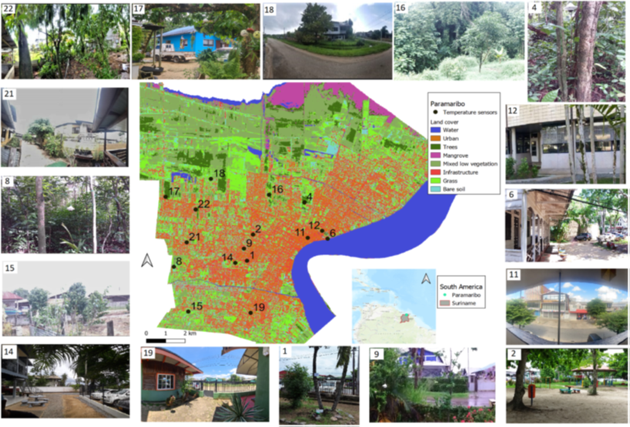Climate Change
How urban green can keep tropical cities cool
6 min
Urban green spaces are considered a nature-based solution to help cities adapt to climate change. A recent study investigates the specifics of this phenomenon in a tropical city to gain a deeper understanding of urban green spaces’ cooling dynamics and support effective greening policies.
Worldwide, there is growing awareness and scientific evidence of the benefits that urban green provides. Forest fragments, trees, other vegetation and green landscaping in cities benefit general well-being in various ways. They cool the immediate environment, combat erosion, promote rainwater infiltration, beautify the city, and ensure a pleasant stay with opportunities for recreation.
However, relatively little is known about urban green in tropical areas. Tropical regions show year-round higher temperatures and humidity compared to temperate regions and are home to different vegetation, so the many available findings about urban green in temperate regions cannot be readily transferred.
Despite advancements in understanding urban green spaces’ cooling in humid tropics, important research gaps remain.
For instance, earlier studies mainly focussed on dry, clear-sky conditions and short study durations, neglecting year-round and seasonal variations. Furthermore, previous research seldom combined characteristics of urban green with both land surface temperature and diurnal air temperature patterns. While air temperature is what humans actually feel, land surface temperatures, as derived from satellites, are much easier to acquire for larger study areas and over longer time periods.
In order to address these gaps, researchers conducted a citizen science study in Paramaribo, the capital of Suriname. Their primary objective was to explore how urban green spaces and other factors influence micro-climate cooling in a tropical city.
To achieve their goals, they analysed diurnal and seasonal dynamics, the extent of green spaces’ cooling, and the relation between locational characteristics and the micro-climate.
Paramaribo has 241,000 inhabitants, which is more than one-third of the entire population of Suriname. This sprawling city has a tropical rainforest climate with a short wet season (December -January), a long wet season (mid-April to mid-August), and two dry seasons (February-mid-April, mid-August-November). Housing is predominantly low-density, and urban green spaces are increasingly sparse.
Over the last few decades, Paramaribo’s uncontrolled urban growth has been marked by a lack of effective greening policies, resulting in fewer public recreational areas and more heat-retaining asphalt and concrete surfaces. Street trees, urban forests, and other vegetation compete with residential and infrastructure projects for space in the city.
The urban green spaces now remaining largely consist of grass, low vegetation, and uncultivated land, with some forest fragments and trees along streets and public squares in the historic downtown area. As climate forecasts for Suriname predict an average temperature rise of 0.3 - 1.3°C over the next decade, more effective greening policies are called for. A better understanding of urban green space cooling dynamics could be very beneficial here.
The study used air temperature and humidity data collected from citizen scientists between July 2021 and June 2022, with temperature sensors placed at 16 locations across Paramaribo (data can be explored here).
This data was complemented by remotely sensed land surface temperatures for the 16 locations. Site selection focused on varying vegetation types, green-to-built-up ratios, and both managed and unmanaged urban green spaces.
Citizens chose sensor locations based on perceived relevance, including land use changes, and worked with project staff for setup and maintenance. They monitored data using a mobile app, ensured sensor upkeep, and reported environmental changes.

Map of the study area and numbered measurement locations (Source: Best et al., 2023)
The researchers observed distinct seasonal and diurnal patterns, revealing that areas with dense, multi-layered tree structures provide stronger cooling effects during the day while grass and low vegetation better release heat during the night.
Among the various types of UGS in Paramaribo, forest fragments showed the most significant cooling impact. The cooling effect generally diminishes with distance from the green space, although deviations occur where additional heat-absorbing or heat-releasing factors – such as impervious surfaces, traffic, or other green spaces – play a role. At night and during the wet season, the cooling influence is less pronounced. This reduction is linked to evapotranspiration, a process in which plants transport water from their roots through their stems, branches, and leaves into the air. Since evapotranspiration-driven cooling is less effective when atmospheric humidity is high, its impact diminishes during these periods.
High correlations were found between various measures of the cooling effect. However, the researchers note that measures like average temperature and nighttime lows represent different aspects of the micro-climate, each impacting human well-being in unique ways. This highlights the challenge of comparing studies focused on single variables. The researchers also found that involving citizen scientists enhances knowledge and raises public awareness about the value of urban green spaces in mitigating heat-related health risks in a warming world.
The researchers recommend further research to gain a better understanding of which urban green space types and plant species are most effective in cooling. This is particularly important in tropical climates, where the relationship between land cover and temperatures is often unclear.
In Suriname and many other humid tropical areas, residents adapt their activities to the climate, seeking shade or air-conditioning during the hottest parts of the day. The researchers surmise that considering the behaviour of residents, especially those without air-conditioning or long commutes, is crucial for addressing temperature extremes and health risks.
To read more on this story, check out our other Geoversity article, An army of egg-sized sensors to hatch a sustainable movement in Paramaribo.
This story is an adaptation of a journal article entitled Urban green spaces and variation in cooling in the humid tropics: The case of Paramaribo. The original article is published under a CC BY 4.0 license and this story has been adapted in accordance with the license.